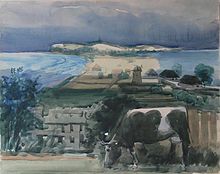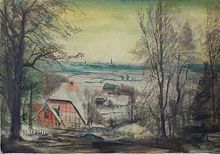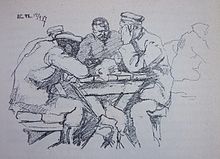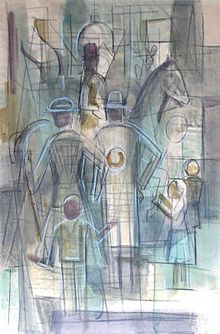Ernst Thoms
Ernst Thoms (born November 13, 1896 in Nienburg / Weser ; † May 11, 1983 in Wietzen ) was a German painter of the New Objectivity .
biography
Childhood and youth
Ernst August Heinrich Thoms was the son of Christiane Schultze and Peter von Jetschewski. After the birth of her son, Christiane Schultze married Heinrich Thoms, who adopted Ernst. As a result, Ernst Thoms had four more siblings.
As a child, Ernst Thoms had the desire to become a painter. His grandmother recognized and encouraged this interest. In 1911 he began an apprenticeship as a house painter with the master painter Ernst Rahlf in Nienburg / Weser. In addition to his training, he continued to practice pictorial design, including by copying postcards, collecting pictures and advertising signs.
The sparseness of the parental home, the social environment in his hometown and the rural surroundings, which Ernst Thoms often roamed in his childhood and youth, shaped the character and artistic development of Thoms and later often inspired him in the choice of subjects for his pictures.
First World War and prisoner of war
At the beginning of the First World War , Ernst Thoms broke off his training shortly before the final exam and volunteered as a soldier at the age of 17. He served as an infantryman. On October 23, 1914, during the First Battle of Flanders near Langemarck , he was taken prisoner by the English, from which he did not return until the end of 1919. Thoms was interned for a year in a POW camp near Templemore in County Tipperary in Ireland, then transferred to a camp in Leigh near Manchester in England for another four years .
In the camp, he compensated for the shock of war experiences and being a prisoner of war with his urge to express himself artistically.
This activity not only gave him inner stability, he also found recognition in the camp with realistic sketches by his comrades and the English guards. At a painting competition held by the Royal Academy in the prisoner-of-war camp, Thoms won second prize for drawing a knitting soldier. The English camp officer Colonel Hartley made friends with Ernst Thoms. He provided him with good paints and pencils, had him portray himself several times and bought these sheets from him at a symbolic fixed price.
Post-war and early work
After his release from captivity and his return to Germany on his 23rd birthday in November 1919, Thoms passed his apprenticeship examination. During this time he often sketched the horrors of his war memories. In 1920 he attended the Hanover School of Applied Arts in the class of Fritz Burger-Mühlfeld . It was here that Friedrich Busack , Grethe Jürgens , Hans Mertens , Gerta Overbeck , Karl Rüter , Erich Wegner and Ernst Thoms got to know each other. From these students a group was formed that became known as the “Hanoverian Group of New Objectivity”.
Ernst Thoms left the arts and crafts school after six months in order to continue his autodidactic training. As an individualist, he strived to find his own artistic path independently. He wanted to develop and deepen the expression, the power and the simplicity of his painterly presentation far from the influence of academic constraints.
He retired to work in his attic studio on Calenberger Strasse in Hanover.
The artistic bond with his classmates at the arts and crafts school loosened, but he remained on friendly terms with them. His fellow student Gerta Overbeck was his partner in the twenties. She portrayed him in 1926.
Despite the friendships within the group of his classmates, he was artistically at a distance, a loner, “indomitable, unadjusted”, a “great rebellious”.
"I am not a product of the imperial high school, but a free wildling."
Thoms devoted himself to the subjects of landscapes, still lifes and portraits in self-study. In addition, he worked as a house painter, as a poster painter and as a stage painter at the Städtische Bühnen Hannover, since until the late twenties he could not make a living from art alone.
"It was the artists in particular who felt the heaviness of the golden twenties."
New objectivity in Hanover
Ernst Thoms characterized his artistic expression and that of the Hanoverian group of Neue Sachlichkeit as follows: “We wanted to make a new beginning after all the experiments. Not a new style, a new attitude. As a principle of the new painting: order and the humane. I have the ambition to be a German painter, with all the ugliness ”.
The Hanoverian painters of the New Objectivity maintained a constructive rigor and a still-life restraint in expression. Her pictures were strictly structured. Sober and related to the present, they presented the reality of the social upheaval in the Weimar Republic after the lost war: direct, closely observing, often tough, but not aggressive.
At the same time, her pictures often have soft, dreamy, poetically atmospheric, sometimes even fairytale-like features. They also had a tendency towards melancholy, which probably explains the frequency of winter images. During the Weimar Republic, the Hanoverian group of the New Objectivity was considered the most closed of this genre.
Ernst Thoms painted, orienting himself on the old German tradition, sober, simple and factual - understandable for everyone. His passion was the landscape, which he preferred to the still life or the portrait. His pictures also reflected a north German seriousness and a certain gravity.
Artistic breakthrough
Kurt Schwitters and Friedrich Vordemberge-Gildewart also lived and worked in Hanover in the 1920s, and they received a lot of attention, while the realism of the group “ New Objectivity ” was felt to be out of date.
Thoms was one of the first representatives of the New Objectivity, who gained recognition at home and abroad from the mid-1920s. From its first exhibition in 1926 at the Kestner Society in Hanover, the Hanover Provincial Museum acquired the painting Attic , a "... typical example of magical realism in Germany". (Georg Jappe). Wieland Schmied described Ernst Thoms as "the most important figure in the Hanoverian group" of the New Objectivity.
In 1927 he took part in the centenary exhibition “Contemporary European Art” in Hamburg. In the same year he won the art competition of the literary magazine Die Literäre Welt , Berlin, with his painting Girls in the Café . Due to this success, the Berlin gallery Neumann-Nierendorf devoted a solo exhibition to Ernst Thoms in 1928, in which 21 paintings and 11 watercolors from his work were shown. Also in 1928 he exhibited at the exhibition "Contemporary Art" in the Kunstpalast in Düsseldorf. Abroad, his pictures were shown in exhibitions in Amsterdam and Stockholm in the late 1920s .
In 1930 Thoms was awarded the Prussian Ministry of Culture's recognition for the portrait of his mother, painted in the manner of the old masters . In the same year, Thoms joined the Hanover Secession ; Then in 1932 to the Deutscher Künstlerbund , after exhibiting there as a guest in 1929 in Cologne, 1930 in Stuttgart and 1931 in Essen.
Turning away from the New Objectivity style
Around 1930/1931 a clear change in style in artistic expression became apparent in Ernst Thoms' work. His landscape representations got more and more space and atmosphere, whereby light and shadow were used effectively. The formal language, which already had the quality of the old masters in the portrait of the mother and horses and trees , changed, especially in his landscape depictions, from a dissecting, technically constructed image structure to a projection of organic order, which for Ernst Thoms can be viewed as new, but overall as traditional.
The dissolution of harshness in expression and form was evident in all painters of the New Objectivity in Hanover from around this point on. The change in Ernst Thoms' work and his turning away from the New Objectivity style went hand in hand with a change in political and social conditions at the end of the Weimar Republic in the run-up to the National Socialist takeover.
"Even before the beginning of the Third Reich, objectivity came to an end."
time of the nationalsocialism
Ernst Thoms did not want to bow to the artistic ideal of National Socialism, the "new type of person". He felt that his artistic freedom and individuality were threatened by the Nazi cultural policy.

Thoms increasingly shifted to the genre of his beloved landscape painting and no longer painted portraits from the mid-1930s. So he largely avoided the argument about the new regime's understanding of art. The National Socialist cultural authorities tolerated some of his pictures and also allowed him to attend some art exhibitions. In 1934, Thoms took part in the Venice Biennale . He combined this exhibition with a trip to Italy, the impressions of which had a clear influence on his future artistic orientation towards landscape views. In the same year he married Grete Giesemann . In the general encyclopedia of fine artists from antiquity to the present from 1939, Thoms was described as a "... expressive, popular, neatly colored painter who paints all details with the greatest conscientiousness". "... the ability to characterize his portraits" was emphasized.
However, Ernst Thoms did not conform to the doctrine of the National Socialist cultural authorities and rejected any form of statecraft. In 1937 the National Socialists confiscated seven of his works from the possession of the City of Hanover and a loan from the Kunsthalle Hamburg as " Degenerate Art ", including the watercolor mountain landscape from 1935 .
In the same year Thoms painted his ambitious painting Tower Building . Similar in terms of motif to the famous painting Tower of Babel by Pieter Bruegel the Elder , it thematically accused the hubris and arrogance of human behavior. It was obvious that this image was not allowed to be made public during the Nazi era. Thoms expressed himself critically in public and was denounced and interrogated several times. His studio was broken into and searched. Friends supported him by buying his paintings.
From 1939 to 1940, Thoms was drafted into military service for the second time, this time involuntarily. He served as a security guard on transport trains. In 1941 his daughter Juliane was born. His studio in Calenberger Neustadt and his apartment in Hanover were bombed in October 1943 in an Allied air raid. His works located there were destroyed. Thoms then moved with his family to an old half-timbered house in Warmsen in his home district of Nienburg / Weser .
In 1943 one of his paintings was exhibited at the Great German Art Exhibition in Munich.
Post-war in Warmsen and return to Hanover

The seven years in Warmsen were marked by hardship. Under the impression of the need and the isolation from his usual Hanoverian surroundings, combined with the impressions of the scenic surroundings of his place of residence on the "Great Moor", his painting style also changed. The fine brushwork of his landscape depictions gave way to pictorial compositions - more and more often in watercolor technique - the effect of which was created by earthy colors in combination with light and shadow. Details dissolved, the contours became more flat.
In 1950, Thoms returned to Hanover with the help of the city administration and then lived at Plathnerstraße 7 in the Zoo district . Since then, urban motifs have appeared more and more frequently in his pictures in addition to his beloved landscapes, such as B. beer tavern, street vendors, fish market, musicians, gas station, street, train station, bridge. On the occasion of his 60th birthday, the local art association dedicated a retrospective to Ernst Thoms.
During this period, Thoms often developed his pictures from the basic geometric shapes of line, circle, triangle and rectangle. The figurative composition of his pictures was often done with two-dimensionally applied colors, often combined with secondary, coarse, simple chalk lines for the figurative border. It is noticeable that, from around the mid-1950s, Thoms basically depicted people in his pictures faceless. From the early 1960s, Ernst Thoms turned to visual design using mixed media .
Late years
Since 1968 he was handicapped by an eye disease, which prevented the development of a later work. After his wife Grete died in 1977, Thoms and his family moved to Wietzen in the Langeln district, where he died in 1983. He is buried in the Kräher Weg cemetery in Nienburg / Weser.
Honors
- In 1930 Thoms was honored with the Prussian Ministry of Culture's recognition prize for the portrait of his mother .
- In 1964, Thoms was awarded the Great Cross of Merit of the Lower Saxony Order of Merit.
- In 1975 he was made an honorary citizen of the city of Nienburg.
- In 1977 he received the Cross of Merit 1st Class of the Order of Merit of the Federal Republic of Germany .
- In hannoveraner district Calenberger Neustadt him the Ernst Thoms-way dedicated.
- In 2014, Ernst-Thoms-Platz in Nienburg was named after him.
Solo and group exhibitions (selection)

- 1926: Ernst Thoms . Kestner Society, Hanover, 23 May - 20 July
- 1927: New Objectivity. The problem of portrait design . Neumann-Nierendorf Gallery, Berlin
- 1927: European contemporary art . Centennial exhibition of the Hamburg Art Association
- 1928: contemporary art . Kunstpalast Düsseldorf
- 1928: Ernst Thoms . Neumann-Nierendorf Gallery, Berlin
- 1928: The New Objectivity in Hanover . Art association in the Altes Museum, Nordhausen, December
- 1929: Ernst Thoms . State building school Nienburg / Weser, around January 29th
- 1929: spring exhibition . Prussian Academy of Arts in Berlin
- 1929: De Onafhankelijken . Vereeniging van beeldende Kunstenaars Amsterdam, Stedelijk Museum , Amsterdam, May 11th - June 10th
- 1929: Autumn exhibition of Hanoverian artists . Kunstverein Hannover, October 13th - November 24th
- 1930: Hanover Secession . Kestner Society Hanover April 16 opening
- 1930: Tysk konst under Två Sekler . Liljevalchs Konsthall , Stockholm, October 4th - November 2nd
- 1931: German Association of Artists . Exhibition halls, Essen, 23 May - 23 August
- 1932: Big anniversary exhibition 1832-1932 . Kunstverein Hannover, March 6th - April
- 1934: 19th Biennale . Venice
- 1943: Great German art exhibition . Munich
- 1950: Ernst Thoms - 25 years of painting . Free group in the Association of Visual Artists Northwest Germany, Wilhelm-Busch-Museum, Hanover, September 2nd - October 1st
- 1953: Third German art exhibition . Albertinum at the Brühlschen Terrasse, Dresden, March 1st - April 30th
- 1957: Retrospective on the occasion of Ernst Thoms' 60th birthday . Kunstverein Hannover, January 20 - February 10
- 1961: New Objectivity . Haus am Waldsee, Berlin, September 26th - October 15th
- 1977: New objectivity and realism . Museum of the Twentieth Century, Vienna, April 21 - July 24
- 1979: Neue Sachlichkeit and german realism of the twenties . Hayward Gallery, London, November 11, 1978 - January 14, 1979
- 1997: Ernst Thomas, works from the 1920s on paper and canvas . Galerie Nikolaus Fischer, Frankfurt am Main, February 6 - April 2, 1997
Literature (selection)
- Will Grohmann : Thomas, Ernst . In: Hans Vollmer (Hrsg.): General lexicon of fine artists from antiquity to the present . Founded by Ulrich Thieme and Felix Becker . tape 33 : Theodotos vacation . EA Seemann, Leipzig 1939, p. 61 . (accidentally wrong name)
- Thoms, Ernst . In: Hans Vollmer (Hrsg.): General lexicon of fine artists from antiquity to the present . Founded by Ulrich Thieme and Felix Becker . tape 33 : Theodotos vacation . EA Seemann, Leipzig 1939, p. 76 .
- Thoms, Ernst . In: Hans Vollmer (Hrsg.): General Lexicon of Fine Artists of the XX. Century. tape 4 : Q-U . EA Seemann, Leipzig 1958, p. 440 .
- Dirk Böttcher : Thoms, Ernst . In: Dirk Böttcher, Klaus Mlynek, Waldemar R. Röhrbein, Hugo Thielen (eds.): Hannoversches Biographisches Lexikon . From the beginning to the present . Schlütersche Verlagsgesellschaft, Hannover 2002, ISBN 3-87706-706-9 , pp. 360–361.
- Ludwig Zerull ( editor , layout), Günter Barz, Michael Herling (photos): Hanoverian painter of the New Objectivity. Accompanying document to the (touring) exhibition of the Niedersächsische Sparkassenstiftung with pictures from the collections of the Stadtsparkasse Hannover , the Niedersächsische Sparkassenstiftung and the Sprengel Museum Hannover . Ed .: Niedersächsische Sparkassenstiftung. Self-published, Hanover 1991, passim
- Christian Fuhrmeister (Ed.): “The strongest expression of our day.” New objectivity in Hanover. Georg Olms Verlag, Hildesheim 2001, ISBN 3-487-11440-2 , pp. 255–257 (catalog of the exhibition in the Sprengel Museum Hannover 2001/2002.)
- Third German art exhibition. Albertinum at the Brühlschen Terrasse, Dresden 1953. Catalog of the exhibition. VEB Verlag der Kunst, 1953.
- Rudolf Lange: Ernst Thoms. Oil paintings - watercolors. Catalog for the exhibition of the same name from August 31 to October 31, 1975 at the Nienburg / Weser University of Applied Sciences. District of Nienburg / Weser (Ed.) 1975.
- H. Detlev Gadesmann, Frauke Krahé: Ernst Thoms. Pictures from Nienburg private collection: Exhibition of the Museum Nienburg 1981 on the artist's 85th birthday. Museum Association for Counties Hoya, Diepholz u. Wolf. Nienburg 1981, ISBN 3-980-20371-9 .
- Christiane Lange : The cool look. Realism of the twenties in Europe and America. Kunsthalle der Hypo-Kulturstiftung München from June 1 to September 2, 2001. Prestel Verlag, ISBN 3-7913-2513-2 .
- Museum Nienburg / Weser, Michael Allnoch (Ed.): Ernst Thoms Catalog raisonné 1920–1983. Museum Nienburg / Weser 2013, ISBN 978-3-9813995-5-4 .
- Friedrich Rasche : Ernst Thoms. Oil paintings, watercolors, drawings at the Kunstverein Hannover from January 20 to February 10, 1957. Catalog of the exhibition, Kunstverein Hannover 1957.
Web links
- Literature by and about Ernst Thoms in the catalog of the German National Library
- Die Neue Sachlichkeit on the website of the German Historical Museum, Berlin
- Ernst Thoms at the Great German Art Exhibition, Munich 1943/1944, on gdk-research.de
- Ernst Thoms at the Third German Art Exhibition, Dresden 1953
- Dr. Anke Twachtmann-Schlichter: Short biography about Ernst Thoms at www.museum-nienburg.de
Individual evidence
- ↑ a b c cf. Hans-Otto Schneegluth: Childhood and Youth 1896 to 1914. From: Museum Nienburg / Weser (ed.): Ernst Thoms. 1896 Nienburg - 1983 Langeln-Wietzen. Memorial exhibition for the 100th birthday on November 13, 1996 in the Museum Nienburg - Quaet-Faslem-Haus and Fresenhof. Museum Association for the Counties of Hoya, Diepholz and Wölpe, Nienburg / Weser 1996, ISBN 3-9802844-4-1 , p. 8 ff.
- ^ Georg Grabenhorst: Ernst Thoms. Lower Saxony Ministry of Culture (ed.). Musterschmidt-Verlag Göttingen 1965, p. 6.
- ↑ Ernst Thoms: Handover of Gaisberg Castle near the border town of Weissenburg (Alsace) on the afternoon of August 4, 1870. Implementation of a postcard motif by the then 17-year-old painter apprentice Ernst Thoms. Provenance: Museum Nienburg / Weser, oil painting, dated and signed ...: E. Thoms (19) 13. Inv no. 2011/0074; Catalog raisonné: Th-00949. A postcard with the original motif is also in the possession of the Museum Nienburg / Weser.
- ↑ a b c d Heinrich-Detlev Gadesmann: "Just paint, paint and be alone". Ernst Thoms. Historical series of publications of the district of Nienburg / Weser (ed.). Special edition 1991
- ↑ a b c d e Heinrich-Detlev Gadesmann: Descriptive catalog of works of Ernst Thoms's oil paintings. Dissertation to obtain the title of Doctor of Philosophy from the University of Hamburg. 1981
- ↑ Georg Grabenhorst: ibid, p. 7: "Prisoners of War", dated E. Th. 9/12/17
- ↑ a b c d Karin stamp : Ernst Thoms. A Hanoverian painter of the New Objectivity. Catalog of the Landesmuseum Oldenburg for the exhibition in the Augusteum from April 28 to June 6, 1982. Peter Reindl (Ed.). Verlag Isensee, Oldenburg 1981, ISBN 3-920557-47-6
- ↑ See Hans Seutemann: Preliminary remarks on the exhibition of paintings by Ernst Thoms in the Kestner Society Hanover from May 23 to July 20, 1926. From: Neue Sachlichkeit in Hanover. Exhibition catalog, Kunstverein Hannover 1974, p. 109
- ↑ Heike Scholz: At the edge of the field of vision. Grethe Jürgens - an artist of the twenties in Hanover. Dissertation at the Philipps University of Marburg 1999, p. 114.
- ↑ a b c Helmut R. Leppien (Red.): New Objectivity in Hanover. Catalog of the exhibition, Kunstverein Hannover 1974
- ^ Heinrich-Detlev Gadesmann: Descriptive catalog of works of the oil paintings by Ernst Thoms. S. 11. Quote from Ernst Thom in an interview with the author
- ↑ a b Georg Reinhardt: Between studio and street. On the history and painting of the New Objectivity in Hanover. From: New Objectivity in Hanover. Catalog of the exhibition, Kunstverein Hannover 1974, p. 8
- ↑ Ursula Bode: We were outsiders. From: Theater , 25th year, edition 11/12, p. 19. Volksbühne Hannover (Ed.) 1974.
- ↑ a b c Cf. Wieland Schmied: New Objectivity and Magical Realism in Germany 1918 - 1933 . Fackelträger-Verlag Hannover 1969, p. 32, p. 66 ff.
- ^ Emil Strodthoff: Brush and palette in Hanover . In: Hannoversches Tageblatt, June 12, 1932. From: Heinrich-Detlev Gadesmann: Descriptive catalog of works of Ernst Thoms's oil paintings. P. 4
- ↑ Quoted from: Georg Hoeltje: Painting "Dutch Landscape". Landscape pictures by Ernst Thoms. In: Westermanns Monatshefte, 81st Jhrg., Vol. 162, 1937, 53 ff. From: Heinrich-Detlev Gadesmann: Descriptive catalog of the oil paintings by Ernst Thoms. P. 5
- ↑ Cf. Georg Jappe: Art of the Twenties. In: Frankfurter Allgemeine Zeitung, September 30, 1967. From: Heinrich-Detlev Gadesmann: Descriptive catalog of works of Ernst Thoms's oil paintings. P. 7
- ^ Ulrich Krempel: The Hanoverian artists of the New Objectivity at art exhibitions from the 1920s to 1940s. From: Christian Fuhrmeister (Ed.): “The strongest expression of our days.” New objectivity in Hanover. P. 30.
- ↑ 1936 forbidden pictures , exhibition catalog for the 34th annual exhibition of the DKB in Bonn, Deutscher Künstlerbund, Berlin 1986. (P. 90: Ernst Thoms (1896–1983) )
- ^ Heinrich-Detlev Gadesmann, F. Krahé: Ernst Thoms - pictures from Nienburg private collection. Exhibition catalog. Nienburg 1981, p. 5.
- ↑ See also: Markus Heinzelmann: The landscape painting of the New Objectivity in Hanover in the twenties and thirties. From: Christian Fuhrmeister (Ed.): “The strongest expression of our days.” New objectivity in Hanover. P. 79 ff.
- ↑ Markus Heinzelmann: ibid, p. 80.
- ↑ Thoms, Ernst . In: Hans Vollmer (Hrsg.): General lexicon of fine artists from antiquity to the present . Founded by Ulrich Thieme and Felix Becker . tape 33 : Theodotos vacation . EA Seemann, Leipzig 1939, p. 76 .
- ↑ Kestner Museum Hannover: Main Book Acquisitions , Volume 4, No. 1928/293, 1930/212, 1931/86, 1932/115, 1935/336, 1936/218, 1936/219.
- ↑ Database on the confiscation inventory of the "Degenerate Art" campaign . Research Center Degenerate Art, FU Berlin, URL: www.emuseum.campus.fu-berlin.de.
- ^ Barbara Schmidt-Vogt: The zoo district in Hanover. The history of a district. Ev.-luth. Friedenskirche, Hannover 2012, p. 117.
| personal data | |
|---|---|
| SURNAME | Thoms, Ernst |
| BRIEF DESCRIPTION | German painter of the New Objectivity |
| DATE OF BIRTH | November 13, 1896 |
| PLACE OF BIRTH | Nienburg / Weser |
| DATE OF DEATH | May 11, 1983 |
| Place of death | Wetting |










